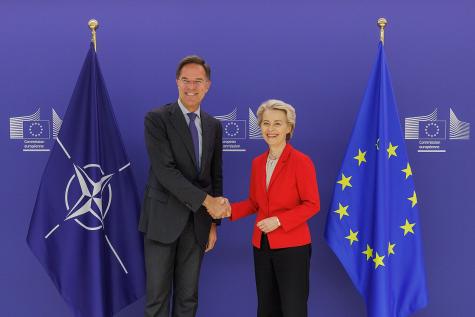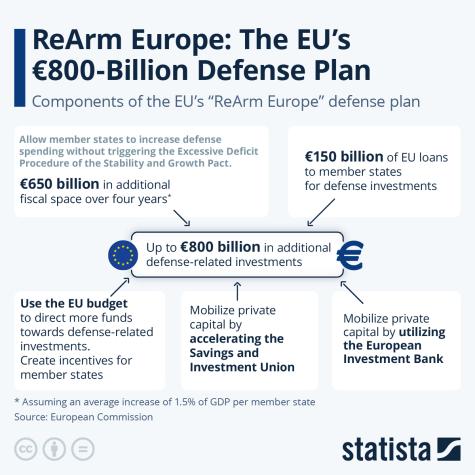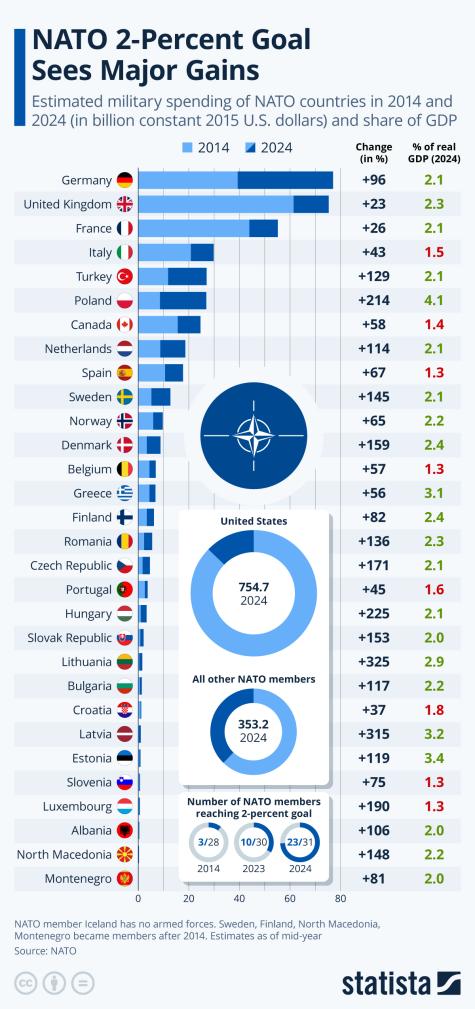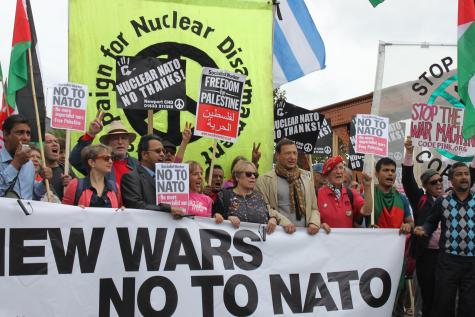EU Special Debts for Rearmament

➡️ EU Loans for Rearmament - Critical Analysis of EU Militarisation
The European Union is undergoing significant reforms of its defence policy, accompanied by an unprecedented increase in military spending and the introduction of new borrowing instruments.
These measures are a direct response to ongoing geopolitical tensions, particularly the war in Ukraine, and the growing uncertainty of U.S. security guarantees under Donald Trump.
In March 2025, the European Commission presented the "Readiness 2030" initiative, known initially as ReArm Europe. The goal is to mobilise €800 billion for defence spending by 2030.
Jump straight to our links on ➡️ EU Rearmament Debt
Explore our comprehensive guides on -
-
NATO, Expansion into the East, and the 2% GDP Goal
A key component of the plan is a €150 billion lending program available to member states for joint armament projects. Relaxation of EU budget rules will enable an additional €650 billion in national defence spending.
The initiative proposes redirecting existing EU funds, such as the cohesion policy (which helps support sustainable development), to defence. The European Investment Bank will play a larger role as restrictions on lending to defence companies will be removed.
Mobilising private capital to create a 'Security Union' will promote further investment in the defence industry.
In 2024, the defence spending of EU Member States reached an enormous €326 billion, approximately 1.9% of EU GDP. This represents a 30% increase compared to 2021. Investments in new defence technologies amounted to €102 billion, with 88% of these funds used to acquire new equipment, including air defence systems, drones, and artillery.

National Policy on Militarisation
Some member states have already taken significant steps to increase their defence budgets. Poland has increased its defence spending to 4.1% of GDP and plans to expand it further in the coming years. France has also committed to increasing its defence budget to €413 billion by 2030 while continuing to modernise its nuclear weapons.
Italy is increasing its investments in cyber defence and modern weapons systems. The Baltic states of Estonia, Latvia, and Lithuania have increased their defence spending significantly above the NATO target to reflect their exposed position in the east.
The introduction of joint EU debt to finance defence is, however, not welcome everywhere. Spain has criticised the idea of joint bonds, and fiscally conservative states like Germany and the Netherlands are sceptical of debt mutualisation.
The new German government, led by Chancellor Friedrich Merz, is pursuing a clear course of military buildup and defence spending intending to transform the Bundeswehr into Europe's strongest army. Special national funds and special EU loans have been utilised for this purpose.
The Bundestag has reformed its debt brake, permitting defence spending above 1% of GDP to no longer count toward regular government debt. A special fund for infrastructure and security investments of up to €500 billion has also been approved.
Fractions are forming within the governing coalition. Merz is focused on military strength and European deterrence, whilst some SPD politicians are warning against excessive militarization. SPD foreign policy expert Ralf Stegner has criticised the plan to increase the defence budget to 5% of GDP, describing it as fiscally irresponsible. Stegner and others have called for a greater balance between security, state welfare, and future investments.

Dangers of EU Rearmament
While geopolitical tensions understandably create pressure for action, accelerated EU militarisation appears to be a risky change of course with unclear long-term consequences.
The massive increase in overall debt and relaxed national spending threaten the already strained economic situation. Even in 2024, the EU's net new debt was around €700 billion – and rising. An expansive defence spending policy could drive inflation and seriously affect the fiscal flexibility of future generations.
According to the Kiel Institute for the World Economy (IfW), the cost of war in Europe would vastly exceed the cost of investing in effective deterrents. How can Europe justify issuing massive joint debt for military purposes while debt rules still restrict investments in climate, education, and social justice?
The Memorandum Group warns that a sharp increase in military spending without tax increases or adjustments to the debt limits will inevitably lead to cuts in social sectors.
The reallocation of existing EU funds to defence spending has controversial implications for democracy. Without broad public debate or sufficient parliamentary oversight, decisions on billion-dollar defence projects could be made in specialised technocratic committees and behind closed doors. The need for a quick defence response should not be at the expense of democracy, especially on issues that fundamentally affect the Union's identity.
Commitment to such high levels of debt, despite no assurance of the plan's effectiveness, is reckless. Currently, the EU's military capabilities are highly fragmented, with armament projects which are often inefficient and nationally isolated.
Without extensive reforms, the EU risks losing billions of Euros in what could be dedicated to national interests. Lifting existing restrictions on arms loans by the European Investment Bank raises concerns that the private interests of military corporations will be prioritised in the future – at the expense of a transparent focus on the common good for everyone.

The director of the Stockholm Peace Research Institute (SIPRI), Dan Smith, recognises the need for increased defence efforts but warns against a hasty approach. He highlighted that Europe already invests more in armaments than Russia, even without the Readiness 2030 plan. Smith calls for careful planning and greater cooperation to effectively deploy resources and ensure long-term security.
With each step toward financial, industrial, and institutional rearmament, the traditional European model of conflict resolution and diplomacy is pushed further into the background. Critics warn that an arms buildup will not make Europe more secure but merely more dependent on a military narrative, with incalculable consequences for Europe as a whole.
Alternatives to EU Rearmament – Diplomacy & Common Security
Given the increasingly volatile situation globally, how can we ensure security sustainably and ethically without undermining democratic, economic and human rights principles? An alternative security strategy requires a more comprehensive approach. It encompasses crisis prevention, resilience, dialogue, diplomatic initiatives, and a targeted reform of the European security narrative.
Substantial funding for crisis prevention and conflict management would tackle the root causes of conflict. In 2023, the EU spent just €2.2 billion on military research and development projects under the European Defence Fund. A total of €280 billion was spent on defence. During the same period, less than €300 million was allocated to conflict prevention measures.
A targeted expansion of these funds to at least €1 billion annually – as proposed by the European Peacebuilding Liaison Office (EPLO) would significantly contribute to defusing global conflict hotspots and raising Europe's peace policy profile.

Strengthening social and economic resilience offers a more effective long-term alternative to traditional military buildup. The Covid-19 pandemic, the war in Ukraine, and the climate crisis have demonstrated how strongly Europe's security depends on functioning supply chains, energy sovereignty, and social cohesion.
Investments in energy independence, for example, through the expansion of renewable energies, would significantly reduce Europe's geopolitical vulnerability. According to the European Commission, full implementation of the REPowerEU plan would require investments of €210 billion by 2030 - substantially less than the planned €800 billion for military purposes, but with far-reaching effects for stability and sustainability.
New impetus is also needed in the diplomatic sphere. Instead of primarily focusing on deterrence, the EU should once again assume a leading role as a mediator, for example, by reactivating multilateral dialogue between NATO, the OSCE, and non-aligned states. A relaunch of the Conventional Armed Forces in Europe treaty (CFE) or a European non-proliferation treaty for autonomous weapons systems would significantly contribute to improved diplomatic efforts. As a broader aim, the EU should take its role as a player in development and climate policy more seriously because stable, fair international relations are by far the best prevention against future conflicts.
Instead of competing for national defence budgets and expensive duplication of military capabilities, the EU could build a leaner, more efficient Security Union based on shared defence competencies, a coordinated procurement policy, and a much larger role for the European External Action Service (EEAS).
According to a report by the European Defense Agency, inefficient structuring already costs the EU €26 billion annually - money that could be saved through smarter integration and then used for sensible alternatives.
Author: Maximilian Stark 26.05.25, translated and edited by Rachael Mellor, licensed under CC BY-SA 4.0
For more information on EU Loans for Rearmament see below ⬇️
- STOP ReArm Europe - welfare, not warfare472275
- 2020s European Rearmament - Wikipedia472274
- Our GERMAN Links on the Topic472273
- Militarism: The greatest threat to security policy today - European Left 473863
- Ursula von der Leyen Is Waging War on Workers - Jacobin 26.06.25476633
- Video: Is debt justified to increase defence investments? - Euronews 11.06.25473667
- Europe’s rearmament: why military Keynesianism is a lie - Morning Star 31.05.25473864
- Infighting around EU rearmament undermines grand ambitions for European defense - Kyiv Independent 29.05.25473678
- Europe’s rearmament: Trump’s new war on China - Morning Star 29.05.25473832
- Banking on Defence: Can a dedicated bank solve Europe’s rearmament financing dilemma? - EPC 22.05.25473665
- Knowing the score: Why EU rearmament must be grounded in political consensus - ECFR 19.05.25473676
- Stop ReArm Europe and the need for a movement against all imperialist aggression - Europe Solidaire Sans Frontieres 09.05.25473912
- Victory in Europe Day: Honour the past, say no to a militarised future - DiEM25 09.05.25473858
- Video: Rearm Europe: the Myth of a European Defence for Peace - Rete Italiana Pace Disarmo 07.05.25473910
- Europe pushing delusional US-style rearmament plan - Responsible Statecraft 01.05.25473679
- How can Europe accelerate its rearmament without breaking the bank? - Bruegel 22.04.25473823
- ReArm Europe, or the myth of a European defence for peace - Rosa Lux 15.04.25473821
- Rearming Europe: Challenges and Constraints - War on the Rocks 15.04.25473825
- Europe’s race to rearm is pointless if its adversaries are waging war online - Guardian 15.04.25473835
- European rearmament: Shuffling fake money around a monopoly board? - Responsible Statecraft 11.04.25473675
- The Labyrinth of European Rearmament - The Nation 09.04.25473828
- Defence or Welfare? Europe Can Afford Both, and Must - Social Europe 07.04.25473852
- The governance and funding of European rearmament - Bruegel 07.04.25473664
- Warmongering Peace: There Is No Alternative to the Rebirth of Europe Through Militarism? - Berliner Gazette 03.04.25473860
- The EU’s rearmament blueprint hinges on uncertain national borrowing - EPC 25.03.25473669
- Europe’s half-baked rearmament boom is already turning into a fiasco - Telegraph 25.03.25473850
- Europe at a Crossroads: Promise and Perils of the ‘ReArm Europe’ Strategy - Geopolitical Monitor 25.03.25473836
- Europe's New Bellicism: Rearmament in a Frenzy - Toda Peace Institute 21.03.25473829
- Is European rearmament the path to security, or a fantasy with no basis in reality? - Matthew Vella 20.03.25473911
- The problem of missing European public goods from the ReArm Europe plan - Bruegel 18.03.25473672
- Who’s going to pay for Europe’s rearmament? It’s time to tax the rich - VOX Europe 17.03.25473666
- Europe’s defence spending spree risks debt crisis, warns Dutch politician - FT 17.03.25473673
- Europe’s rearmament plan could lead to economic collapse, warns economist - Energy Terminal 15.03.25473674
- What Europe’s New Rearmament Plan Gets Wrong - Time 14.03.25473831
- Europe’s Military Build-Up: Will Social Spending Be Sacrificed? - Social Europe 14.03.25473849
- Is Europe really re-arming? - Chalmermagne 12.03.25473909
- As Europe rearms, bond funds are ripping up the rule book - Bloomberg 12.03.25473851
- Rearming Europe is the EU's next folly, Yanis Varoufakis tells Euronews - Euronews 10.03.25473827
- European rearmament is a losing bet - Telegraph 09.03.25473830
- The militarisation of the EU is a danger to peace and a setback to the peoples’ living standards - Liberation 09.03.25473859
- Europe Has Just Become a More Dangerous Place - European Conservative 08.03.25473848
- The economic and political risks of re-arming Europe - ING 07.03.25473670
- Video: How can the EU unlock up to €800bn for its ‘rearmament plan’? - Euronews 06.03.25473662
- The Case Against European Rearmament - Project Syndicate 06.03.25473677
- The Case Against European Rearmament - Tipp Insights 06.03.25473834
- Von der Leyen’s ‘Rearm Europe’ plan and the holes in it - Euractiv 05.03.25473847
- Europe’s rearmament is off to a feeble start - Spectator 05.03.25473826
- Europe’s Looming Guns vs. Butter Decision - FP 04.03.25473854
- Questioning rearmament in a world increasingly incapable of diplomacy - Vatican News 03/25473833
- War, not peace, driving European reboot hopes - Reuters 26.02.25473865
- Can Europe fundamentally reshape its economies to focus on defence? - WEF 19.02.25473853
- Donald Trump’s Mission Impossible: Making Europe Pay for Their Own Defense - CATO 10.02.25473856
- Why Europe's drive to rearm is stalling - Le Monde 25.01.25473822
- European Common Debt: Is defence different? - CER 05.11.24473671
- Europe Has a Painful Choice: War vs. Welfare - Tovima 24.09.24473855
- The European Union Charts Its Own Path for European Rearmament - CSIS 08.03.24473824
- 1000 researchers and scientists oppose the European Defence Fund - SGR 17.04.19473862
- The EU defence fund at a glance, and why it is not good for peace nor for Europe - ENAAT 15.04.19473857
- Make peace, not war: Stop the European Defence Fund - Euractiv 05.09.17473861